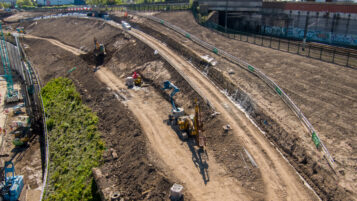
Esh Construction, Aarsleff Ground Engineering and Sunderland City Council have worked in collaboration to deliver four significant retaining structures in a geotechnical engineering feat on Phase 3 of the Sunderland Strategic Transport Corridor, located in England.
In just over 12 months, a soil nail wall formed at a 70 degree angle up to 12 meters high and 250 meters in length, a large kingpost retaining wall 250 meters in length, 85 meters of contiguous bored pile reinforced concrete retaining wall, and a 65-meter reinforced concrete L-shaped wall supported on continuous flight auger-piled foundations, have been installed.
The £40m SSTC3 project will create a new uninterrupted dual-carriageway link to the Northern Spire bridge and the city center. SSTC3 begins at the southern end of the Northern Spire and continues through the former Pallion Shipyard, underneath the Queen Alexandra Bridge, into Deptford Terrace and onto the city center.
 Aarsleff Ground Engineering was appointed by Esh to undertake the design and geotechnical works package for the significant retaining structures, which were necessary to create space for the highway between the former Pallion Shipyard, the upper existing highway and the Tyne & Wear Metro line.
Aarsleff Ground Engineering was appointed by Esh to undertake the design and geotechnical works package for the significant retaining structures, which were necessary to create space for the highway between the former Pallion Shipyard, the upper existing highway and the Tyne & Wear Metro line.
To make the new highway possible, the retaining structures and slope stabilization works were essential in navigating a height difference of approximately 20 meters between the bordering land with existing land falling steeply across the site.
The king post retaining wall between the north side of the new highway and the former Pallion Shipyard sits directly in front of an old retaining structure, which is assumed to have no retaining capacity but had to be incorporated into the scheme. Using precast concrete infill panels, it is constructed against an existing reinforced concrete kingpost wall structure and supported on reinforced concrete pad foundations.
Owing to the site’s previous use as a shipyard, numerous unchartered structures—buried asbestos and existing deep drainage culverts—the ground conditions encountered on the soil nail wall were mixed. The aggressive nature of the ground meant that differential movement and associated settlement needed to be considered and dealt with to provide the required 120-year design life.
The soil nail wall is due for completion in March 2021 which will mark 80% completion of the project.


 Join our thriving community of 70,000+ superintendents and trade professionals on LinkedIn!
Join our thriving community of 70,000+ superintendents and trade professionals on LinkedIn! Search our job board for your next opportunity, or post an opening within your company.
Search our job board for your next opportunity, or post an opening within your company. Subscribe to our monthly
Construction Superintendent eNewsletter and stay current.
Subscribe to our monthly
Construction Superintendent eNewsletter and stay current.